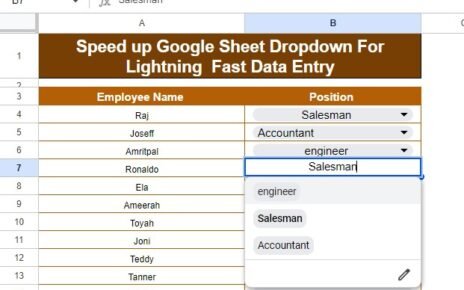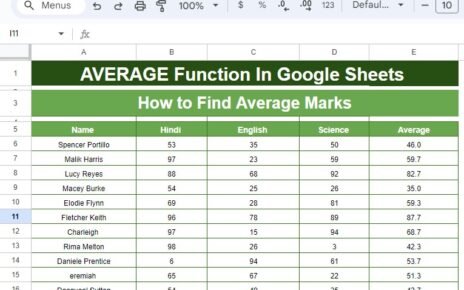In the event management industry, keeping track of key performance indicators (KPIs) is essential to ensure the success of events, optimize operations, and improve client satisfaction. A well-designed KPI dashboard allows event managers to monitor progress in real time, making data-driven decisions to achieve their goals.
In this article, we will explore the Event Management KPI Dashboard in Google Sheets—a ready-to-use template designed to help event managers track essential KPIs efficiently. This guide will cover the KPIs, their definitions, formulas, and whether they should be “lower the better” or “upper the better.”
Key Features of the Event Management KPI Dashboard in Google Sheets
Before diving into the specifics of the KPIs, let’s first understand the key features of this dashboard template:
Dashboard Sheet Tab
-
This is the main sheet where all KPI information is displayed.
-
Month Selection: On Range D3, you can select the month from the drop-down menu, and the entire dashboard will update accordingly.
-
MTD (Month-to-Date): Displays actual values, targets, and comparisons with previous year data using conditional formatting (up or down arrows).
-
YTD (Year-to-Date): Shows cumulative performance with comparisons to targets and previous year data.

Click to buy Event Management KPI Dashboard in Google Sheets
KPI Trend Sheet Tab
-
Select KPIs from the dropdown in Range C3.
-
Displays KPI group, unit of measure, type (Lower the Better or Upper the Better), formula, and definition.
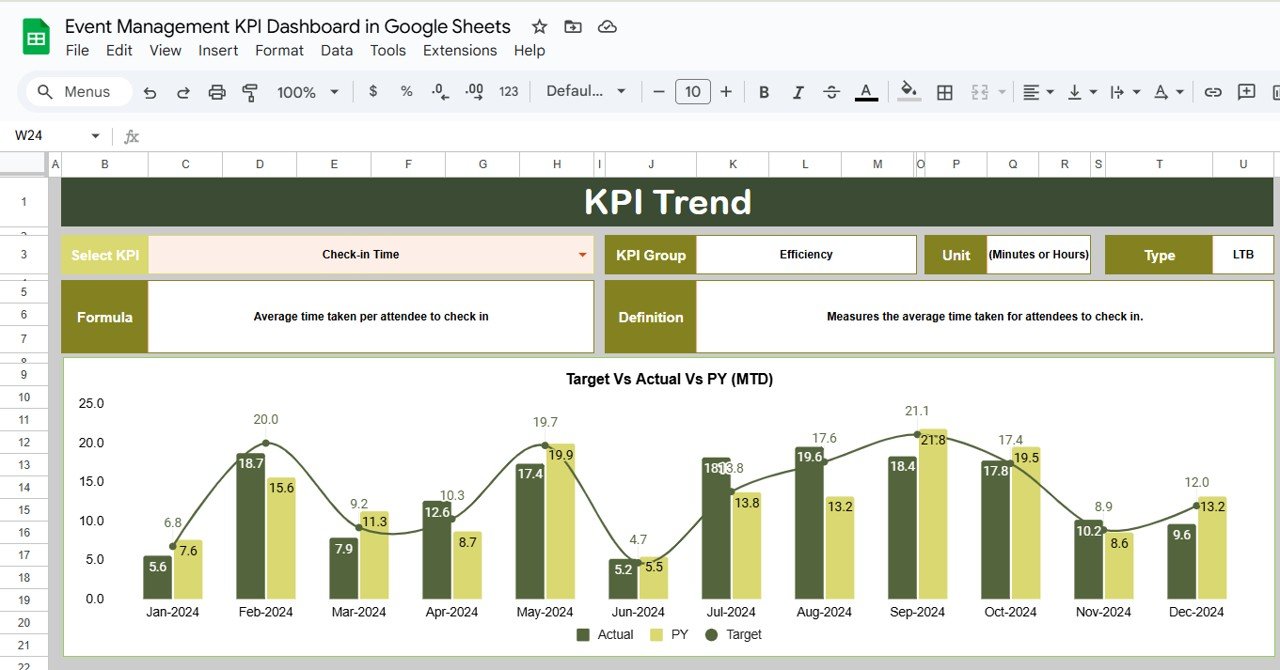
Actual Number Sheet Tab
-
Input actual numbers for both YTD and MTD for a given month.
-
Change the month from Range E1 by inputting the first month of the year.
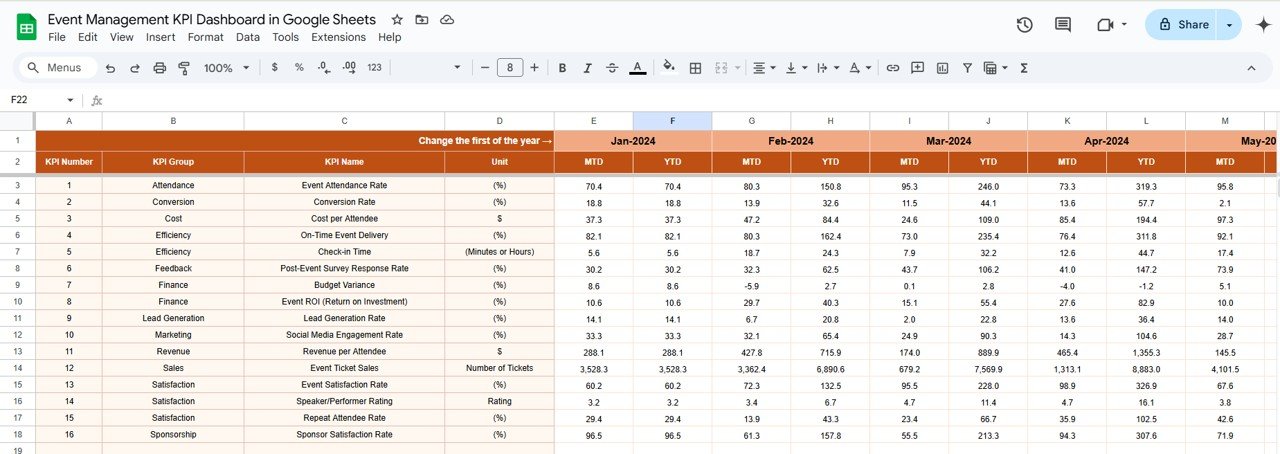
Click to buy Event Management KPI Dashboard in Google Sheets
Target Sheet Tab
-
Enter target values for each KPI for MTD and YTD.
-
Helps track performance against set goals.
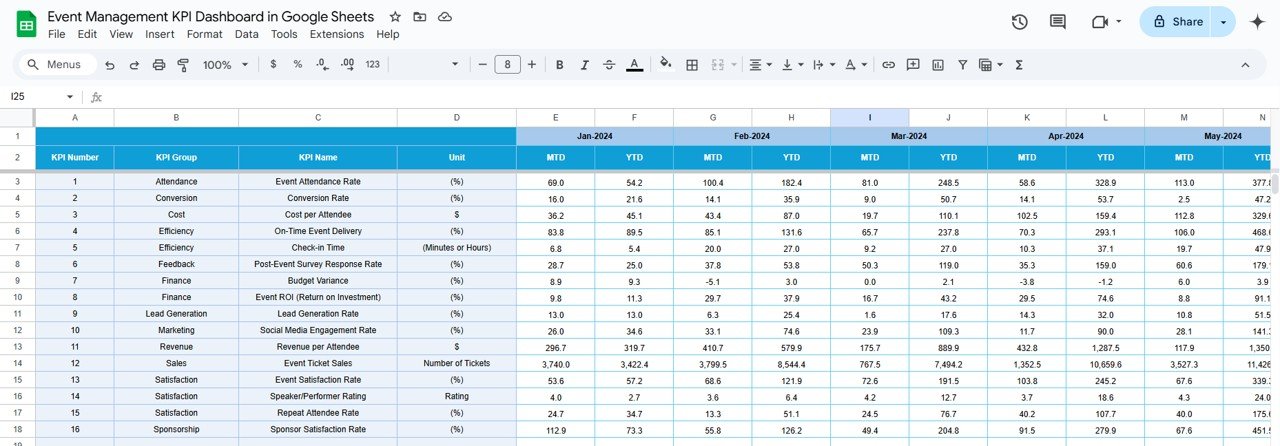
Previous Year Number Sheet Tab
-
Enter data for the previous year, mirroring the format of the current year’s data for accurate year-over-year comparison.

Click to buy Event Management KPI Dashboard in Google Sheets
KPI Definition Sheet Tab
-
Provides detailed information for each KPI, including:
- KPI Name
- KPI Group
- Unit of Measure
- Formula used to calculate the KPI
- Definition explaining the KPI

Advantages of Using the Event Management KPI Dashboard in Google Sheets
An Event Management KPI Dashboard in Google Sheets offers several advantages to businesses in the event planning industry. Here are the key benefits:
-
Real-Time Monitoring: Track KPIs in real-time, enabling immediate decision-making and quick responses to issues.
-
Customizable Templates: Easily customize the dashboard by adding or removing KPIs, adjusting formulas, and tailoring data to suit your event management needs.
-
Cost-Effective: Google Sheets is free, making it an affordable solution for small to large event management companies.
-
Cloud-Based Collaboration: Teams can collaborate in real time, ensuring everyone has access to the most up-to-date information.
-
Accessibility: Google Sheets is accessible from any device with an internet connection, so you can manage your events from anywhere.
Opportunities for Improvement in the Event Management KPI Dashboard
Click to buy Event Management KPI Dashboard in Google Sheets
While the Event Management KPI Dashboard in Google Sheets is already a powerful tool, there are opportunities for improvement:
Automating Data Entry:
- Current Challenge: Manual data entry can be time-consuming and prone to human error.
- Opportunity: Integrate the dashboard with external systems (e.g., CRM, ticketing systems) to automate data entry and minimize mistakes.
Advanced Visualizations:
- Current Challenge: The dashboard currently provides basic visualizations.
- Opportunity: Add more advanced visualizations like sparklines, heatmaps, or custom charts to make the data more visually engaging and insightful.
-
Customizable Reporting:
- Current Challenge: The dashboard offers basic reporting features.
- Opportunity: Expand reporting features by adding customizable report generation options, such as PDF exports or automated email summaries.
Best Practices for Using the Event Management KPI Dashboard
To get the most out of the Event Management KPI Dashboard in Google Sheets, consider these best practices:
-
Update Data Regularly: Keep your data updated to ensure accurate and timely insights into your event’s performance.
-
Set Realistic Targets: Base targets on historical data and past performance to set achievable goals for your events.
-
Encourage Team Collaboration: Share the dashboard with all key stakeholders to keep everyone informed and aligned.
-
Monitor Post-Event Engagement: Don’t just focus on the event day; track attendee engagement after the event for further insights into your event’s success.
-
Leverage Conditional Formatting: Use conditional formatting to make trends and issues immediately visible (e.g., up/down arrows, color coding).
Conclusion
The Event Management KPI Dashboard in Google Sheets is a highly efficient tool for tracking key performance metrics in the event planning industry. With this dashboard, event managers can monitor the success of their events, ensure operations are on track, and make informed decisions to improve future events.
Frequently Asked Questions (FAQs)
What is a KPI in event management? A KPI (Key Performance Indicator) is a measurable value that shows how effectively an event is achieving its goals. Common KPIs in event management include attendance rates, budget variance, and customer satisfaction.
How do I customize my Event Management KPI Dashboard? You can customize the dashboard by adding new KPIs, modifying formulas, and changing the layout to suit your specific event management needs.
How do I enter data into the Event Management KPI Dashboard? Enter the actual numbers for MTD (Month-to-Date) and YTD (Year-to-Date) data into the relevant sheets, such as the Actual Numbers Sheet, Target Sheet, and Previous Year Numbers Sheet.
Can I automate the data entry process? Yes, integrating with external systems (like CRM or ticketing platforms) can automate data entry and reduce manual input errors.
Which KPIs should I track for my events? Essential KPIs for event management include event attendance, budget variance, customer satisfaction, lead generation rate, and post-event engagement.
Visit our YouTube channel to learn step-by-step video tutorials
Youtube.com/@NeotechNavigators
Watch the step-by-step video Demo:
Click to buy Event Management KPI Dashboard in Google Sheets

